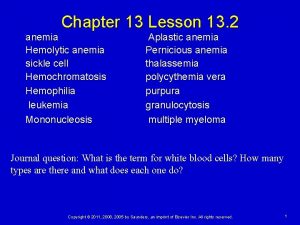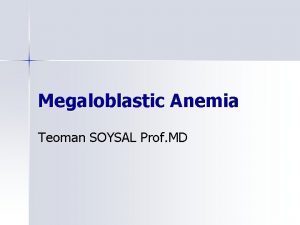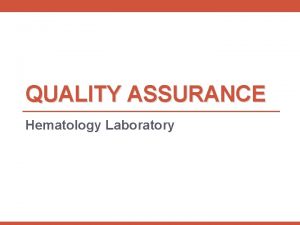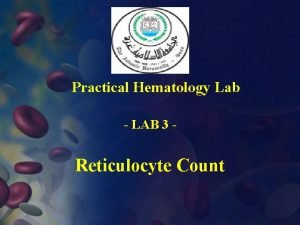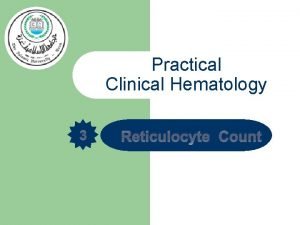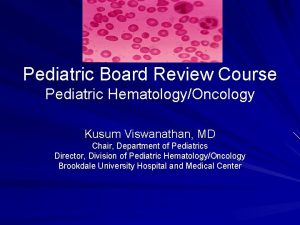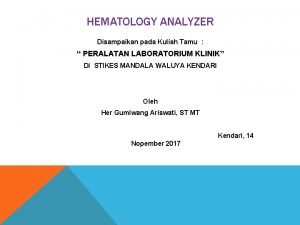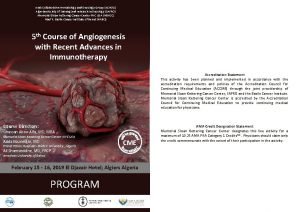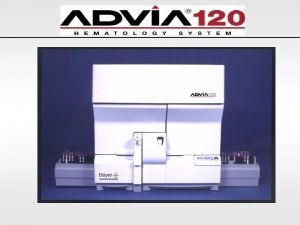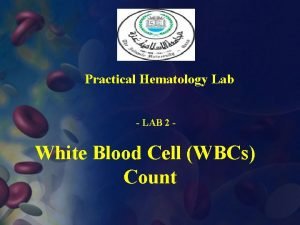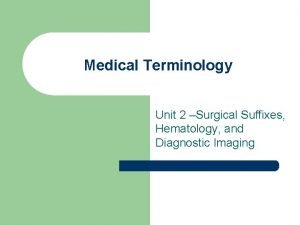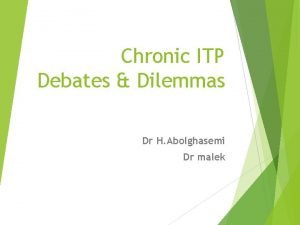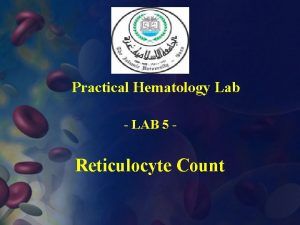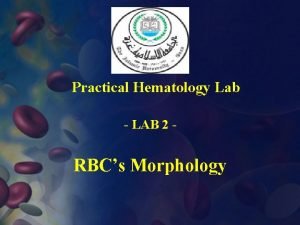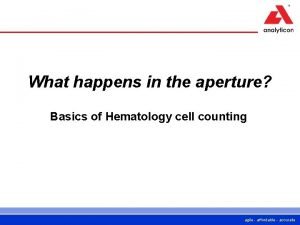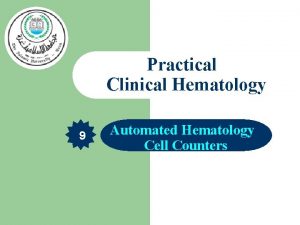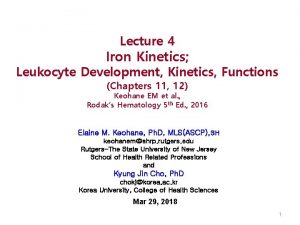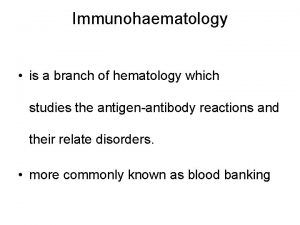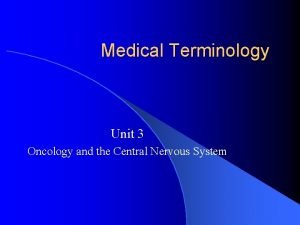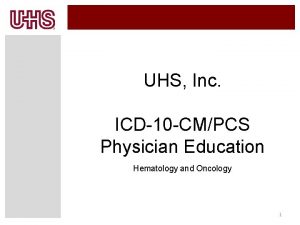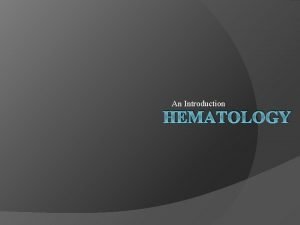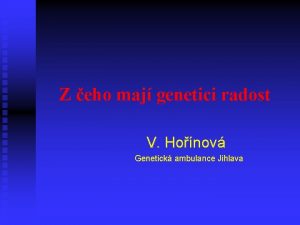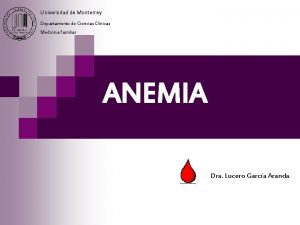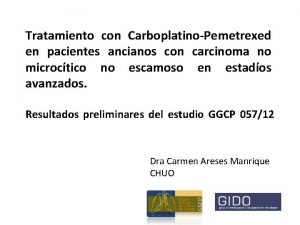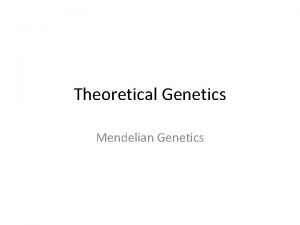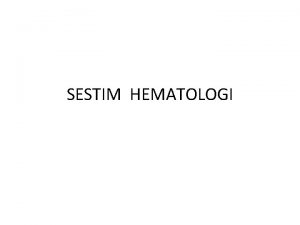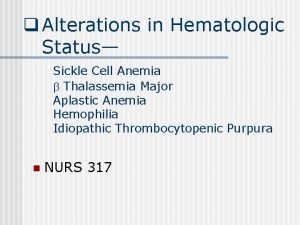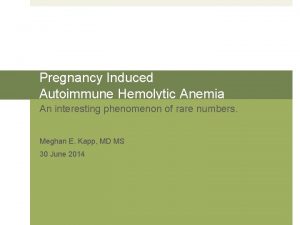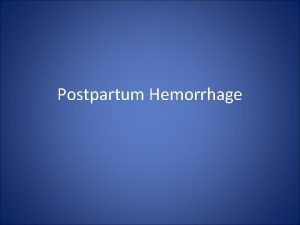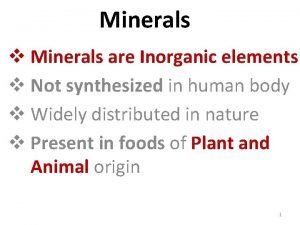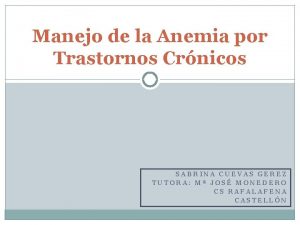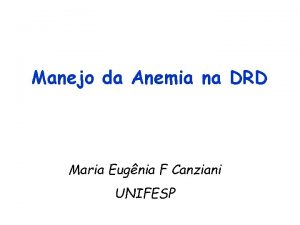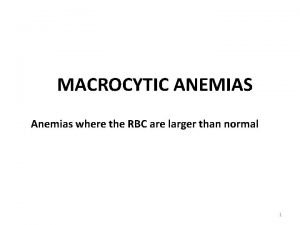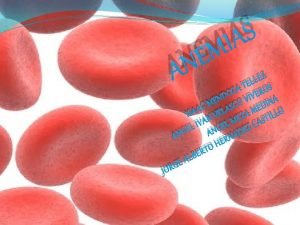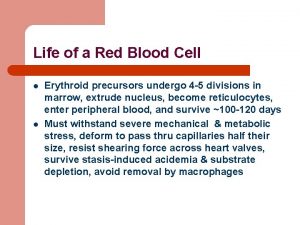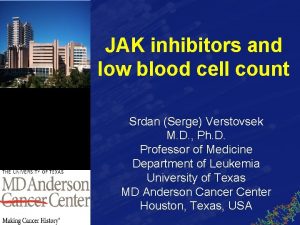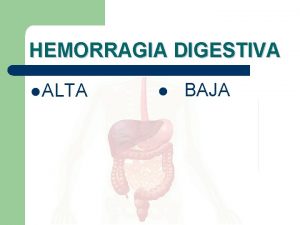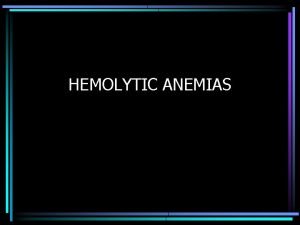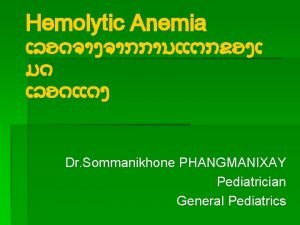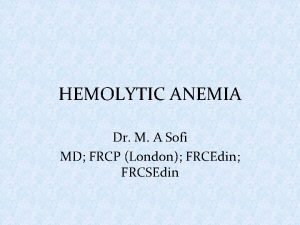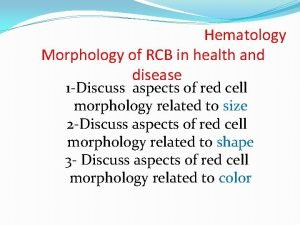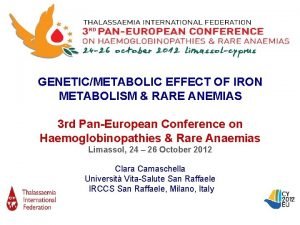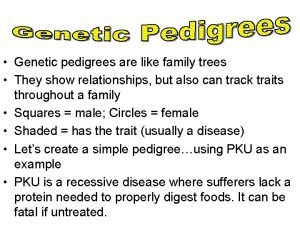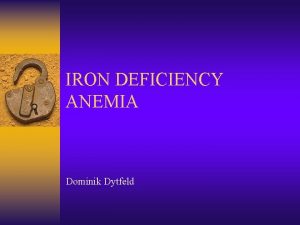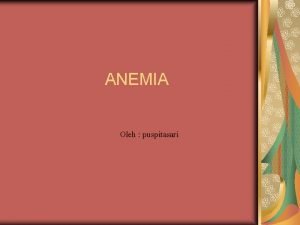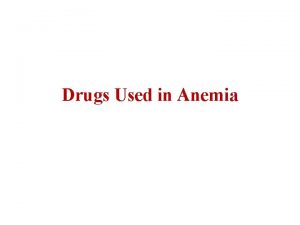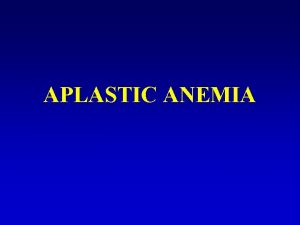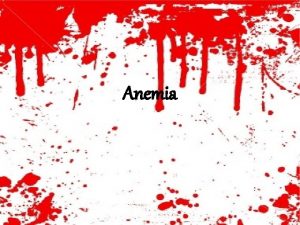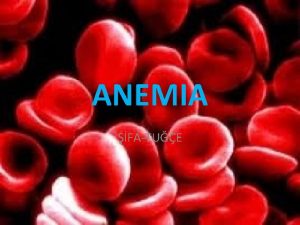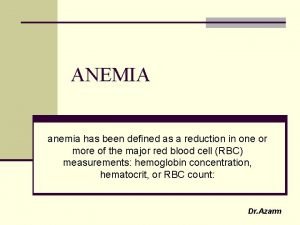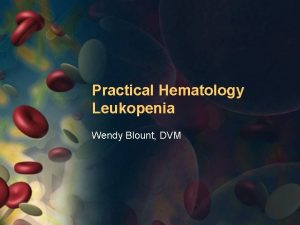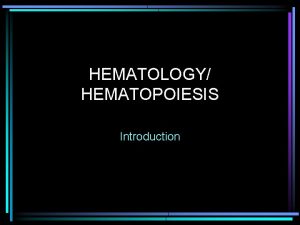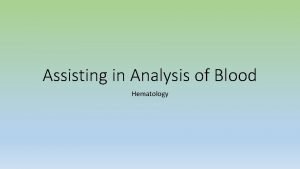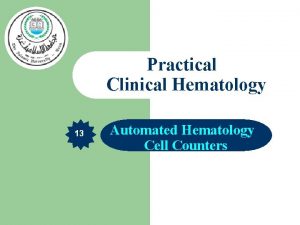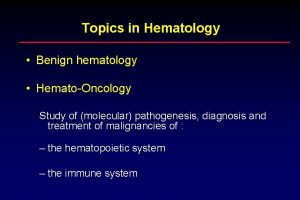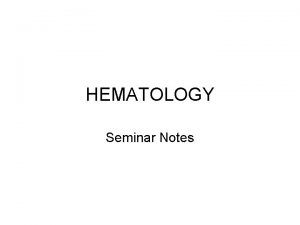Hematology Anemia Definition Anemia is a reduction in









































































![Acquired aplastic anemia • Causes include drugs (sulfonamides, anticonvulsants, chloramphenicol), infections ([HIV], [EBV], [CMV], Acquired aplastic anemia • Causes include drugs (sulfonamides, anticonvulsants, chloramphenicol), infections ([HIV], [EBV], [CMV],](https://slidetodoc.com/presentation_image_h2/a99497ba125461f450d5c157d9a75ef8/image-74.jpg)

- Slides: 75

Hematology



Anemia • Definition. Anemia is a reduction in the red blood cell (RBC) number or in the hemoglobin (Hgb) concentration to a level more than 2 standard deviations below the mean. • The hemoglobin is high at birth in most newborns and then declines, reaching the physiologic lowest point (nadir) between 2 and 3 months of age in the term infant and between 1 and 2 months of age in the preterm infant.

• Fetal hemoglobin (Hgb F) is a major constituent of Hgb during fetal and early postnatal life. It declines and gradually disappears by 6– 9 months of age. • Anemia is one of the most common laboratory abnormalities during childhood. • Approximately 20% of all children in the United States and 80% of children in developing nations have anemia at some time during childhood.

• Classification is made on the basis of the mean corpuscular volume (MCV) • Microcytic, hypochromic anemia (small, pale RBCs; low MCV) • Macrocytic anemia (large RBCs; high MCV) • Normocytic, normochromic anemia (normal RBCs in size, color, and shape; normal MCV)

Classification • Classification based on reticulocyte count is also helpful. • The reticulocyte count reflects the number of immature RBCs in the circulation • The usual percentage of RBCs that are reticulocytes is 1% (normal absolute count = 50, 000 cells/mm 3).

• In the steady state, when a patient has a normal Hgb level, the reticulocytes should constitute 1% of all RBCs. • In most anemias, reticulocyte counts should rise. A low reticulocyte count indicates bone marrow failure or diminished hematopoiesis.

Clinical Features of Anemia • Mild • Pallor (noted especially on skin and on mucous membranes) • Moderate • Weakness and fatigue • Decreased exercise tolerance • Irritability • Tachycardia • Tachypnea • Anorexia • Systolic heart murmur

Clinical Features of Anemia • • • Severe Congestive heart failure Cardiac dilation Shortness of breath Hepatosplenomegaly Spoon-shaped nails

Microcytic, hypochromic anemias • The two most common types of microcytic, hypochromic anemia during childhood are iron-deficiency anemia and β-thalassemia minor.

Iron-deficiency anemia • Is the most common blood disease during infancy and childhood. • The majority of cases are caused by inadequate iron intake. • Nutritional iron deficiency is most common in two age groups. • Nine to twenty-four months of age: owing to inadequate intake and inadequate iron stores (which are typically depleted by 4– 6 months of age).

Iron-deficiency anemia • The typical toddler’s diet consists of large quantities of iron-poor cow’s milk. • Iron rich foods (e. g. , iron-fortified cereal, meats, legumes) or iron supplementation is therefore recommended beginning at 4– 6 months of age to prevent anemia.

Iron-deficiency anemia • Adolescent girls: owing to poor diet, rapid growth, and loss of iron in menstrual blood • Occult blood loss : • Polyps, Meckel diverticulum, (IBD), PUD, celiac disease, and the early ingestion of whole cow’s milk before 1 year of age.

Laboratory findings • Because iron stores disappear first, an early finding of irondeficiency anemia is low serum ferritin. • Ferritin is also an acute-phase reactant, it may be increased in infection, disease states, and stress, therefore appearing normal. • As serum iron decreases, iron-binding capacity increases • Other findings include a normal or decreased reticulocyte count.

Management • Elemental iron (4– 6 mg/kg/day) is prescribed orally for mild to moderate anemia. • Iron is given with vitamin C • Dietary counseling • RBC transfusion may be required for severe anemia associated with cardiovascular compromise • Further evaluation to rule out other causes of anemia is necessary in patients with anemia unresponsive to iron.

α-Thalassemia and β-thalassemia syndromes • Thalassemia is a group of inherited anemias characterized by defective synthesis of one of the Hgb chains • Normally, the major Hgb in RBCs is hemoglobin A 1, a tetramer of two α- chains and two β-chains. • Hgb. A 2 and Hgb F may also be present in small amounts.

• α-Thalassemia results from defective α-globin chain synthesis, and β- thalassemia results from defective β-globin chain synthesis. • Both types of thalassemia result in hemolysis that leads to increased bone marrow activity. • As marrow activity increases, the marrow spaces enlarge, increasing the size of bones in the face, skull, and other bones if severe and untreated.

α-Thalassemia • Is the result of deletions of the α-globin chain and occurs predominantly in Southeast Asians. • Silent carrier. One α-globin gene is deleted. Patients have no anemia and are asymptomatic. • α-Thalassemia minor. Two α-globin genes are deleted. Patients have mild microcytic anemia.

α-THALASSEMIA Silent carrier α-/αα Normal complete blood count αα/- - (αthalassemia 1) or α - Mild microcytic α-Thalassemia trait /α - (α-thalassemia anemia 2) Hemoglobin H α -/- - Hydrops fetalis - -/- - Microcytic anemia and mild hemolysis; not transfusiondependent Severe anemia, intrauterine anasarca from congestive heart failure; death in

α-Thalassemia • Hgb H disease. Three α-globin genes are deleted. Patients have moderate to severe anemia at birth • Fetal hydrops. Four α-globin genes are deleted. • Only Hgb Bart’s are formed, and in utero, this causes profound anemia, congestive heart failure (CHF), and death if not identified early enough for intrauterine transfusion to occur.

β-Thalassemia • Is the result of mutations of the β-globin chain. Because there are only two β-globin genes in each cell, there are only two states: • β-Thalassemia major (Cooley anemia ) may be caused by either total absence of the β-globin chains or deficient β-globin chain production. • β-Thalassemia major occurs predominantly among patients of Mediterranean background.

DISORDER GENOTYPIC ABNORMALITY CLINICAL PHENOTYPE β-THALASSEMIA Thalassemia major (Cooley’s anemia) Homozygous β 0 thalassemia Compound Thalassemia intermedia heterozygous β 0 - and β+-thalassemia Thalassemia minor Heterozygous β 0 - and β+-thalassemia Severe hemolysis, ineffective erythropoiesis, transfusion dependency, hepatosplenomegaly, iron overload Moderate hemolysis, splenomegaly, moderately severe anemia, but not transfusion-dependent; main life- threatening complication is iron overload Microcytosis, mild anemia

Clinical features • Profound hemolytic anemia beginning in infancy • Hepatosplenomegaly • If untreated, bone marrow hyperplasia in sites that result in a characteristic “thalassemia facies” (frontal bossing, maxillary hyperplasia with prominent cheekbones, and skull deformities). • Delayed growth and puberty may also be present

Laboratory findings • Severe hypochromia and microcytosis, elevated reticulocyte count • Elevated unconjugated bilirubin, serum iron, and lactate dehydrogenase (LDH) • Electrophoresis demonstrates low or absent Hgb A and elevated Hgb F.

Management • Lifelong transfusions • Chelation therapy to avoid iron overload and often splenectomy. • Bone marrow transplant is curative and is therapy of choice.

Complications • Hemochromatosis (iron accumulation within the heart, liver, lungs, pancreas, and skin) is a major complication and is caused by increased iron absorption from the intestine and from iron in transfused RBCs. • Chelation of iron with the intravenous agent deferoxamine and/or the oral agent deferasirox promotes iron excretion and may help prevent or delay hemochromatosis.

β-Thalassemia minor • Mild asymptomatic anemia • hypochromia and microcytosis • No treatment is required. • Patients with thalassemia minor have normal to elevated RBC counts as opposed to iron deficiency in which the RBC count is low to normal.

Sideroblastic anemia • Is a group of anemias characterized by the presence of ring sideroblasts in the bone marrow. • Ring sideroblasts result from the accumulation of iron in the mitochondria of RBC precursors. • Sideroblastic anemia may be inherited or may be acquired as a result of drugs or toxins (e. g. , isoniazid, alcohol, lead poisoning, chloramphenicol).

• Lead poisoning and chronic diseases, such as malignancy, infections, and kidney disease may present with a microcytic, hypochromic anemia.

Macrocytic (megaloblastic) anemias • These anemias are characterized by large RBCs with MCV > 95. The two major causes in children are folic acid and vitamin B 12 deficiencies. • In addition, rare but important causes of macrocytic anemia include bone marrow failure syndromes

Folic acid deficiency • Decreased folic acid intake (i. e. , from a diet lacking uncooked fresh fruits and vegetables or from exclusive feedings with goat’s milk • Decreased intestinal absorption of folic acid • (from diseases affecting the small intestine, such as celiac disease, chronic infectious enteritis, Crohn disease, or medications, such as anticonvulsants and oral contraceptives).

Folic acid deficiency • In addition to the characteristic signs and symptoms of anemia, patients may have failure to thrive, chronic diarrhea, and irritability. • Diagnosis. Documentation of low serum folic acid is diagnostic. • Management. Treatment includes dietary folic acid and identification and treatment of the underlying cause.

Vitamin B 12 deficiency • Normal physiology. To be absorbed, dietary vitamin B 12 must first combine with a glycoprotein (intrinsic factor) secreted by the gastric parietal cells. • Absorption then occurs in the terminal ileum. • Causes include inadequate dietary intake (e. g. , from a strict vegetarian [vegan] diet) • Inherited inability to secrete intrinsic factor (juvenile pernicious anemia) • or an inability to absorb vitamin B 12 (e. g. , Crohn disease, short gut syndrome).

Vitamin B 12 deficiency • In addition to the characteristic features of anemia, patients may also have anorexia, a smooth red tongue, and neurologic manifestations (such as ataxia, hyporeflexia, and positive Babinski responses). • Diagnosis. Documentation of low serum vitamin B 12 level is diagnostic. • Management. Treatment is by monthly intramuscular vitamin B 12 injections.

Normocytic, normochromic anemias • These anemias are characterized by normal size (normal MCV) and shape of the RBCs. • Common causes include hemolytic anemias (premature destruction of RBCs), some RBC aplasias, and sickle cell (SS) anemia.

• Reticulocyte count may be used to differentiate among the disorders • Low reticulocyte count reflects bone marrow suppression or failure and can be seen with RBC aplasias, viral suppression, medication effect, and pancytopenia associated with aplastic anemia. • High reticulocyte count reflects high bone marrow production of RBCs as seen in hemolytic anemias, recent acute hemorrhage

Hemolytic anemias • Intrinsic RBC defects that cause hemolysis include : • RBC membrane disorders include hereditary spherocytosis and hereditary elliptocytosis • RBC enzyme disorders include glucose-6 -phosphate dehydrogenase (G 6 PD) deficiency and pyruvate kinase (PK) deficiency.

Hereditary spherocytosis • Most common inherited abnormality of the RBC membrane • occurs predominantly in persons of Northern European • There is a large spectrum of phenotypes, with some patients who are largely asymptomatic and others who are transfusion-dependent starting in infancy. • There is a deficiency or abnormality of the structural RBC membrane protein spectrin, causing the RBC to assume its spherical shape. • Inheritance is usually autosomal dominant.

Hereditary spherocytosis • Infants may present with jaundice and anemia. • By 2– 3 years of age, patients develop pallor, weakness, and splenomegaly, as spherocytes are trapped in the spleen and destroyed. • Other complications include aplastic crises, most commonly associated with parvovirus B 19 infection, and pigmentary gallstones.

Hereditary spherocytosis • Laboratory findings • Elevated reticulocyte count, hyperbilirubinemia • Spherocytes on blood smear, increased MCHC (mean corpuscular hemoglobin concentration) • Abnormal RBC fragility with osmotic fragility studies.

Hereditary spherocytosis • Management. • Treatment includes transfusions • Splenectomy cures the disorder • Is generally delayed until after 5 years of age.

Hereditary elliptocytosis • Autosomal dominant defect in the structure of spectrin • Clinical features are more variable than in hereditary spherocytosis. • The majority of patients are asymptomatic, although 10% have jaundice at birth, and later may develop splenomegaly and gallstones. • Treatment includes splenectomy for patients with severe chronic hemolysis.

Glucose-6 -phosphate dehydrogenase deficiency • (G 6 PD) is the most common RBC enzymatic defect. It may occur as an acute hemolytic disease, induced by infection or medications, or as a chronic hemolytic disease. • X linked disease • Triggers of hemolysis • Infection • Fava beans • Drugs (e. g. , sulfa, salicylates, antimalarials)

PK deficiency • Is an autosomal recessive disorder • Clinical features include pallor, jaundice, and splenomegaly. • Kernicterus has been reported in neonates. • Laboratory findings include varying degrees of anemia and a blood smear showing polychromatic RBCs. • Diagnosis is by finding decreased PK activity in the RBCs. • Management includes transfusions and splenectomy for severe disease.

Defects extrinsic to the RBC that cause hemolysis • Autoimmune hemolytic anemia (AIHA) occurs when antibodies are misdirected against the RBCs. • Primary AIHA is generally idiopathic in which no underlying disease is identified. Viral infections and occasionally drugs may be causal in some patients. • Secondary AIHA is associated with an underlying disease process, such as lymphoma, systemic lupus erythematosus (SLE), or immunodeficiency

• Clinical features • Fulminant acute-type AIHA occurs in infants and young children and is preceded by a respiratory infection. • Presenting features include the acute onset of pallor, jaundice, hemoglobinuria, and splenomegaly. • Complete recovery is expected. • Prolonged-type AIHA is characterized by a protracted course and high mortality. Underlying disease is frequently present.

• Laboratory findings. Studies show severe anemia, spherocytes on blood smear, prominent reticulocytosis, and leukocytosis. • A direct Coombs test is positive (detects coating of antibodies on the surface of RBCs or complement).

• Management. Treatment may include transfusions that unfortunately may provide only transient benefit. • Corticosteroids are often used for severe anemia and are continued until hemolysis diminishes. • The acute form responds well to steroids

• Alloimmune hemolytic anemia occurs when antibodies from someone else are directed at the patients’ RBCs • Rh hemolytic disease occurs when the mother, who has no Rh antigen (maternal Rh negative), produces antibodies to the Rh antigen on her fetus’s RBCs (fetal Rh positive). • In subsequent pregnancies, antibodies pass from the mother to the fetus causing hemolysis that presents as severe jaundice (which can lead to kernicterus), anemia, hepatosplenomegaly, and hydrops fetalis. • A direct Coombs test is strongly positive.

• ABO hemolytic disease occurs when the mother is blood group O and her fetus is blood group A, B, or AB. • The mother produces antibodies to either the A or B blood group antigen that then pass to the fetus causing hemolysis with resultant jaundice. • A direct Coombs test is weakly positive. • Of note, ABO disease can occur in the first pregnancy, unlike Rh hemolytic disease. • Management. Treatment may include phototherapy for mild to moderate jaundice and exchange transfusion for severe jaundice.

Microangiopathic hemolytic anemia • This form of anemia results from mechanical damage to RBCs caused by passage through an injured vascular endothelium. • Causes include severe hypertension, hemolytic uremic syndrome (HUS), TTP, artificial heart valves, a giant hemangioma, and disseminated intravascular coagulation (DIC).

• Signs and symptoms are those characteristic of anemia and thrombocytopenia. • Studies show RBC fragmentation seen as “burr” cells and Schistocytes, along wit thrombocytopenia. • Management. Therapy includes supportive care and treatment of the underlying cause.

SS hemoglobinopathies • SS disease occurs in 1 in 800 black newborns in the United States • Eight percent have S trait • Compound heterozygotic disease can occur with Hgb C or β-thalassemia, leading to Hgb SC or sickle β-thalassemia disease, respectively.

• SS disease is caused by a single amino acid substitution of valine for glutamic acid on the number 6 position of the β-globin chain of Hgb. • The mutation results in polymerization of Hgb within the RBC membrane when the RBC is exposed to low oxygen or acidosis. • Polymerization of Hgb results in a distorted RBC shape (sickled) that leads to decreased RBC life span (hemolysis) and occlusion of small vessels, resulting in distal ischemia, infarction, and organ dysfunction.

• SS disease is the result of having two genes for Hgb S (homozygous). • S trait is defined as having only one gene for Hgb S (heterozygous). • Persons with S trait have Hgb A (50– 60%), Hgb S (35 – 45%), and a small percentage of Hgb F. Patients are asymptomatic without anemia unless exposed to severe hypoxemia. • Some patients have an inability to concentrate the urine or may present with hematuria (5%) during adolescence.

• Diagnosis of SS disease is now usually made at birth through newborn screening programs. • Hgb electrophoresis is a highly sensitive and specific test that demonstrates Hgb S and Hgb F (fetal hemoglobin) in the newborn with SS disease.

• Clinical characteristics are not generally present until protective Hgb F declines (by 6 months of age). • Clinical episodes are often termed crises because they occur suddenly.

PERCENT HEMOGLOBIN GENOT YPE CLINIC AL Hb A Hb S CONDIT ION Hb A 2 Hb F Hb C OTHER FINDING(S) SA Sickle cell 55– 60 40– 45 trait 2– 3 – Usually asymptomatic SS Sickle cell 0 anemia – Clinically severe anemia; Hb F heterogeneous in distribution Sickle cell S-β° –β° thalassemi 0 thalassemi a a 85– 95 70– 80 2– 3 3– 5 – 5– 15 10– 20 – Moderately severe anemia; splenomegaly in 50%; smear: hypochromic, microcytic anemia

Sickle cell S-β+ thalassemi 10– 20 thalassemi a a SC Hb SC disease S-HPFH Sicklehereditary 0 persistenc e of Hb F 0 60– 75 45– 50 70– 80 3– 5 – 1– 2 10– 20– 30 – Hb F distributed heterogeneously; mild microcytic anemia 45– 50 Moderately severe anemia; splenomegaly; retinopathy; target cells – Often asymptomatic; Hb F is uniformly distributed

Anemia Chronic, onset 3– 4 mo of age; may require folate therapy for chronic hemolysis; hemoglobin usually 6 -10 g/d. L Aplastic crisis Parvovirus infection, reticulocytopenia; acute and reversible; may need transfusion Sequestration crisis Massive splenomegaly (may involve liver), shock; treat with transfusion Hemolytic crisis May be associated with G 6 PD deficiency Dactylitis Hand-foot swelling in early infancy Painful crisis Microvascular painful vasoocclusive infarcts of muscle, bone marrow, lung, intestines Cerebrovascular accidents Large and small vessel occlusion → thrombosis/bleeding (stroke); requires chronic transfusion Acute chest syndrome Infection, asthma, atelectasis, infarction, fat emboli, severe hypoxemia, infiltrate, dyspnea, absent breath sounds Chronic lung disease Pulmonary fibrosis, restrictive lung disease, cor pulmonale, pulmonary hypertension

Ocular Retinopathy Gallbladder disease Bilirubin stones; cholecystitis Renal Hematuria, papillary necrosis, renal concentrating defect; nephropathy Cardiomyopathy Heart failure Skeletal Osteonecrosis (avascular) of femoral or humeral head Leg ulceration Seen in older patients Infections Functional asplenia, defects in properdin system; pneumococcal bacteremia, meningitis, and arthritis; deafness from meningitis; Salmonella and Staphylococcus aureus osteomyelitis; severe Mycoplasma pneumonia Growth failure, delayed puberty May respond to nutritional supplements Psychological problems Narcotic addiction (rare), dependence unusual; chronic illness, chronic pain syndrome

Usual Laboratory Findings in Sickle Cell Anemia Red blood cell life span 10– 50 days Hemoglobin 6– 9 g/d. L Reticulocyte count 5– 15% Bilirubin Increased Blood smear Sickled cells, target cells, Howell–Jolly bodies • Bone marrow Erythroid hyperplasia • • •

Management • Historically, infection was the leading cause of death due to impaired splenic function. • Patients are at risk for infection with encapsulated bacteria (Haemophilus influenzae type b, Streptococcus pneumoniae, Salmonella, Neisseria meningitidis). • Fever in any patient with SS disease is managed with urgent assessment and appropriate cultures (blood and urine), chest radiograph to rule out pneumonia, and parenteral antibiotics until bacterial infection can be safely excluded.

• Osteomyelitis may occur and may mimic a painful bone crisis. • Infection is most commonly caused by Salmonella species although Staphylococcus aureus may also cause osteomyelitis. • Clinical features include fever and pain, induration, tenderness, warmth, and erythema of the involved area. • Treatment includes appropriate intravenous antibiotics.

Preventive care • Hydroxyurea, a chemotherapeutic agent that increases Hgb F, has been shown to decrease the incidence of vaso-occlusive crises. • Daily oral penicillin prophylaxis is started in the first few months of life to decrease the risk of S. pneumoniae infection. • Daily folic acid is given to prevent folic acid deficiency. • Routine immunizations and also yearly influenza vaccination, 23 -valent polysaccharide pneumococcal vaccine at 2 years of age, and meningococcal vaccine should all be given.

• Serial transcranial Doppler ultrasound or magnetic resonance angiography is recommended beginning at 2 years of age to identify patients at increased risk for stroke. • Bone marrow transplant is curative and is considered for children with severe manifestations.

Prognosis • Median life expectancy is in the 50 s. • Long-term complications include delayed growth and puberty, cardiomegaly, hemochromatosis, cor pulmonale, pulmonary hypertension, renal insufficiency, gallstones, poor wound healing, avascular necrosis of the femoral and humeral heads, osteopenia, retinopathy, and diminished cognitive and school performance.

• Other SS diseases include sickle cell–thalassemia disease (with clinical features similar to SS disease) • sickle cell–hemoglobin C disease (Hgb SC disease) caused by the inheritance of both Hgb S and Hgb C genes. • Clinical features of Hgb SC disease are less severe than SS disease.

RBC aplasias • A group of congenital or acquired blood disorders characterized by anemia, reticulocytopenia, and a paucity of RBC precursors in the bone marrow. • Three most common disorders occurring in childhood • Congenital hypoplastic anemia (Diamond–Blackfan anemia), • Transient erythroblastopenia of childhood, • Parvovirus B 19–associated RBC aplasia

Pancytopenia and Aplastic Anemia • Pancytopenia is defined as low white blood cells (WBCs), RBCs, and platelets and implies bone marrow failure. • Pancytopenia may be congenital or acquired. • Congenital aplastic anemia is also known as Fanconi anemia.

Fanconi anemia • Inheritance is autosomal recessive. • Onset of bone marrow failure occurs at a mean age of 7 years. • Typical presentation is with ecchymosis and petechiae. • Skeletal abnormalities, which include short stature in almost all patients, and absence or hypoplasia of the thumb and radius • Skin hyperpigmentation • Renal abnormalities, including renal tubular acidosis

Fanconi anemia • Studies show pancytopenia, RBC macrocytosis, low reticulocyte count, elevated Hgb F, and bone marrow hypocellularity. • Treatment includes transfusions of RBCs and platelets • Bone marrow transplant • Immunosuppressive therapy (e. g. , corticosteroids, cyclosporin) may also help.
![Acquired aplastic anemia Causes include drugs sulfonamides anticonvulsants chloramphenicol infections HIV EBV CMV Acquired aplastic anemia • Causes include drugs (sulfonamides, anticonvulsants, chloramphenicol), infections ([HIV], [EBV], [CMV],](https://slidetodoc.com/presentation_image_h2/a99497ba125461f450d5c157d9a75ef8/image-74.jpg)
Acquired aplastic anemia • Causes include drugs (sulfonamides, anticonvulsants, chloramphenicol), infections ([HIV], [EBV], [CMV], hepatitis), chemicals, and radiation. • These all may damage bone marrow stem cells directly or may induce autoimmune destruction. • Acquired aplastic anemia is most often idiopathic.

Acquired aplastic anemia • Signs and symptoms include bruising, petechiae, pallor, and fatigue, or serious infection as a result of neutropenia. • Studies show pancytopenia, low reticulocyte count, and hypocellular bone marrow. • Treatment includes identifying and stopping the causative agent, transfusions as needed, bone marrow transplant, and immunosuppressive therapy.
 Pernicious anemia vs megaloblastic anemia
Pernicious anemia vs megaloblastic anemia Investigation of megaloblastic anemia
Investigation of megaloblastic anemia Causes of macrocytic anemia
Causes of macrocytic anemia Unc hematology and oncology
Unc hematology and oncology Quality control in hematology
Quality control in hematology How to calculate rpi hematology
How to calculate rpi hematology Reticulocyte count calculator
Reticulocyte count calculator Pediatric hematology/oncology board review questions
Pediatric hematology/oncology board review questions Hematology analyzer diagram
Hematology analyzer diagram Achog
Achog Advia 120 reagents
Advia 120 reagents Wbc thoma pipette
Wbc thoma pipette Ectomy examples
Ectomy examples Leukostasis symptoms
Leukostasis symptoms American society of hematology
American society of hematology Clexane mechanism of action
Clexane mechanism of action Diagnostic suffixes examples
Diagnostic suffixes examples Rpi formula hematology
Rpi formula hematology Schistocytes causes
Schistocytes causes Riordan clinic
Riordan clinic Hematology
Hematology Medical hematology student lectures
Medical hematology student lectures Reticulocyte
Reticulocyte Practical hematology
Practical hematology Hypochromic red cell
Hypochromic red cell Promonocyte
Promonocyte Branches of hematology
Branches of hematology Wbc differential
Wbc differential Dr. biren saraiya hematology
Dr. biren saraiya hematology Oncology prefix
Oncology prefix Automation in hematology wikipedia
Automation in hematology wikipedia Hematology day
Hematology day Uhs hematology
Uhs hematology Umkc gme
Umkc gme Introduction of hematology
Introduction of hematology Clark hull drive reduction theory
Clark hull drive reduction theory Oxidation examples
Oxidation examples Mikromandibula
Mikromandibula Acute blood loss anemia
Acute blood loss anemia Mil eritrocito monterrey
Mil eritrocito monterrey Grados de anemia
Grados de anemia Sickle cell anemia genotype and phenotype
Sickle cell anemia genotype and phenotype Hematogi
Hematogi Hemoglobina normal en adolescentes
Hemoglobina normal en adolescentes Aplastic crisis
Aplastic crisis Anemia in pregnancy guideline
Anemia in pregnancy guideline Dopament
Dopament Anemia and uterine atony
Anemia and uterine atony What does infected lochia look like
What does infected lochia look like Intravascular hemolytic anemia
Intravascular hemolytic anemia Gambar anemia sel sabit
Gambar anemia sel sabit Anemia in bangladesh
Anemia in bangladesh Missense mutation in sickle cell anemia
Missense mutation in sickle cell anemia Iron deficiency anemia smear
Iron deficiency anemia smear Labs for iron deficiency anemia
Labs for iron deficiency anemia Sabrina prater
Sabrina prater Anemia normocítica normocrômica
Anemia normocítica normocrômica Megaloblastic anemia mcv
Megaloblastic anemia mcv Macrocytic non megaloblastic anemia
Macrocytic non megaloblastic anemia Anemia normocitica normocromica
Anemia normocitica normocromica Causes of hemolysis
Causes of hemolysis Niños con anemia
Niños con anemia Grade 3 anemia
Grade 3 anemia What is severe iron deficiency
What is severe iron deficiency Signs of low iron
Signs of low iron Hematemesis en borra de cafe
Hematemesis en borra de cafe Types of hemolytic anemia
Types of hemolytic anemia Acquired hemolytic anemia
Acquired hemolytic anemia What causes hemolytic anemia
What causes hemolytic anemia Hemolysis treatment
Hemolysis treatment Morphological types of anemia
Morphological types of anemia Anemia sideroblastica
Anemia sideroblastica Symptoms of microcytic anemia
Symptoms of microcytic anemia Sideroblastic anemia
Sideroblastic anemia Sickle cell pedigree
Sickle cell pedigree Dianocitos enfermedad
Dianocitos enfermedad
